Why is sous vide the ideal method to cook a tri tip? No other method has the power to tenderize this generally firmer, yet intensely flavorful cut of meat without turning it to mush. Sous Vide tri tip belongs on your short list of things to try sous vide.
What exactly is tri tip? Tri tip is a relatively small triangular cut of beef from the hip area of the cow in the bottom sirloin.
This cut of beef is well balanced as it tends to be lightly marbled yet very flavorful since it’s one of the muscles that are being used more often by the animal. The precise low and slow cooking that only the sous vide method allows produces results exactly to your liking.
This sous vide tri tip recipe amps up the cook time to tenderize the meat. Finish options are grilled over oak for a traditional method or over a skillet for ease.
- Related article: Best Cuts of Steak to Cook Sous Vide

Table of Contents
Trimming Notes
An untrimmed tri tip will weigh roughly 5 lbs. vs a trimmed tri tip of 2-3 lbs. If your cut comes with the full fat cap on, you should obviously trim it substantially.
In the case your tri tip has been butcher trimmed, use your discretion based on how much further to take it based on how much fat is left. Given the tri tip is generally leaner, we prefer not to trim all of the fat off.
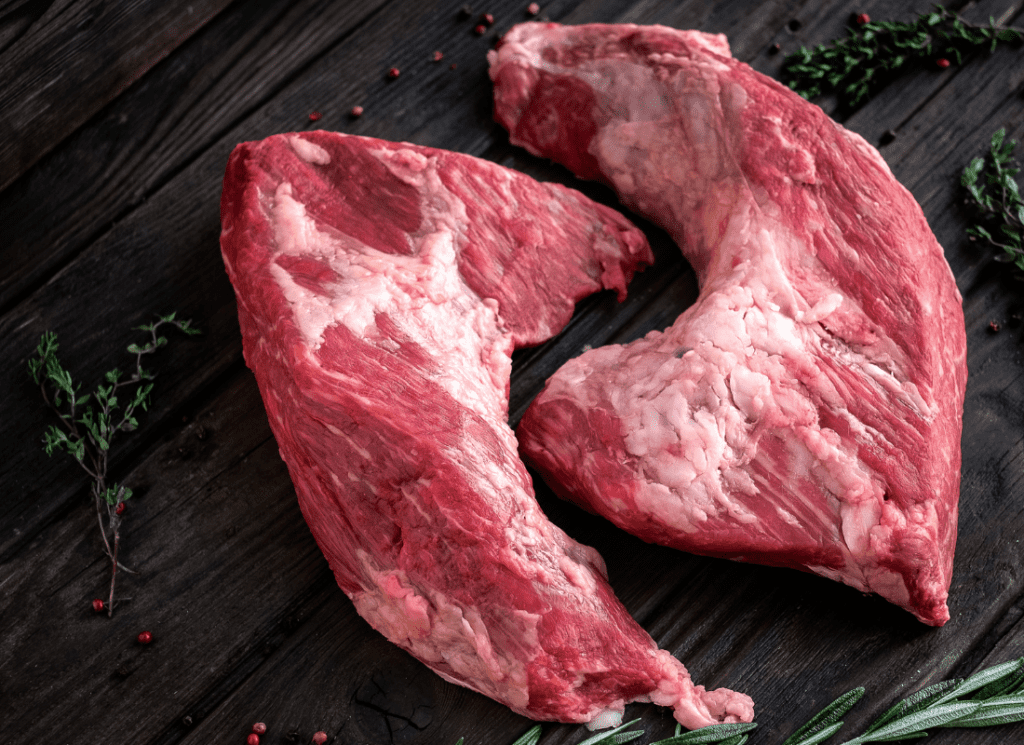
That said, we would remove any pieces of hard white fat and remove any silver skin if visible. No need to fret over a perfect trim.
Sous Vide Immersion Prep
The basic premise of sous vide cooking utilizes an airtight bag submerged in water to cook at low temperatures for longer periods of time. This type of water immersion technique cooking method requires that sous vide foods are put into watertight tight sealed bags, devoid of as much air as possible.
There are two common practices to bag foods appropriately to cook sous vide: using a vacuum sealer and the water displacement method.
A vacuum sealer is the optimal method to ensure all air is removed from the bag with a tight seal. You can find the right sous vide vacuum sealer for you here.
The water displacement method is an effective and convenient method that can be used with Ziploc or silicone bags. After filling the bag with the appropriate food contents, you lower the bag into the water to displace the air out of the bag and seal on the follow.
Either method can be used for this recipe.
Sous Vide Time and Temperature
Our preferred time and temperature for tri-tip is 130°F (54°C) for 4 hours. This leads to a tender tri tip with a rosy pink medium-rare finish that maintains a firmer steak consistency. You can extend the time several hours for a more melt in your mouth consistency we associate more so with roasts. See reference guide below to adjust the time and temperature to your liking.
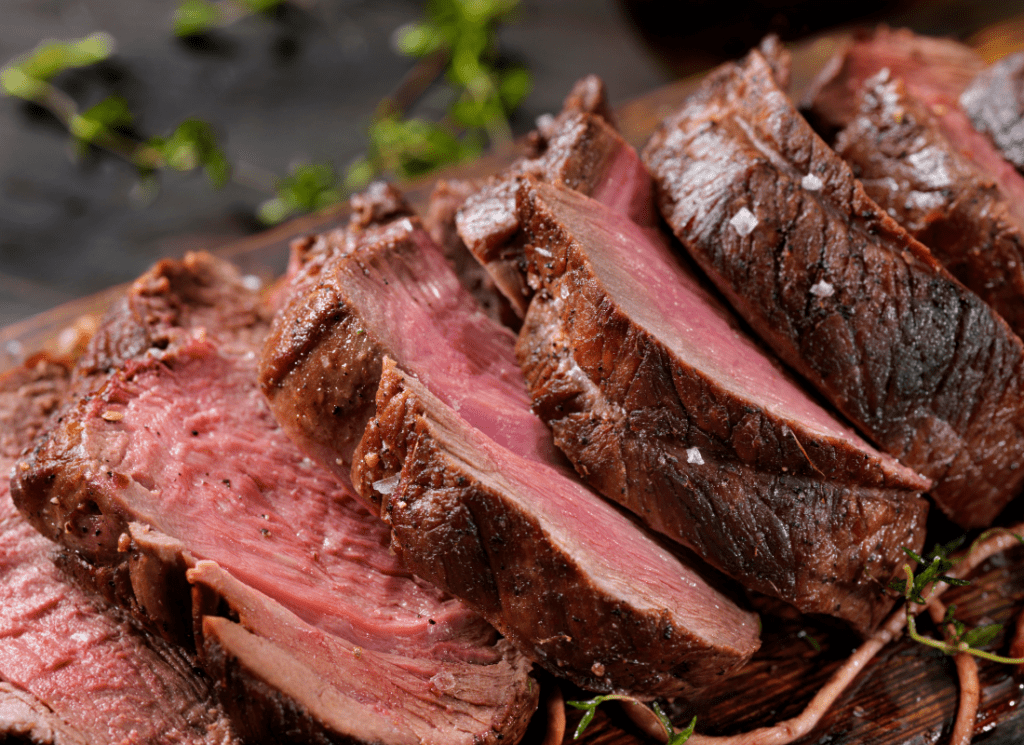
Sous Vide Tri Tip Time and Temperature Chart
Keep in mind the sear will raise the internal temperature ~3°F.
For a steak like finish, as we’ve suggested above:
| Target Doneness | Temp Range | Timing (Hours) |
| Very rare to rare + | 120°F (49°C) to 129°F (54°C) | 2.5 |
| Medium-rare | 130°F (54°C) to 135°F (57°C) | 3 – 4 |
| Medium | 136°F (57°C) to 142°F (61°C) | 3 – 4 |
| Medium-well | 143°F (61°C) to 155°F (68°C) | 3.5 |
| Well done | 156°F (69°C) + | 3 |
For a roast like finish:
| Target Doneness | Temperature Range | Timing (Hours) |
| Very rare to rare + | 120°F (49°C) to 129°F (54°C) | 8 |
| Medium-rare | 130°F (54°C) to 135°F (57°C) | 10 – 12 |
| Medium | 136°F (57°C) to 142°F (61°C) | 10 – 12 |
| Medium-well | 143°F (61°C) to 155°F (68°C) | 11 |
| Well done | 156°F (69°C) + | 10 |
Sear to Finish
Searing is critical to having your steak be plate ready. Not only does the searing process add color to the dish, but also adds depth of flavor, texture and locks in juices.
The critical steps to get a great crust are:
- Dry the meat thoroughly by patting with a paper towel
- Season the meat generously with seasoning such as salt and pepper
- Use extremely high heat
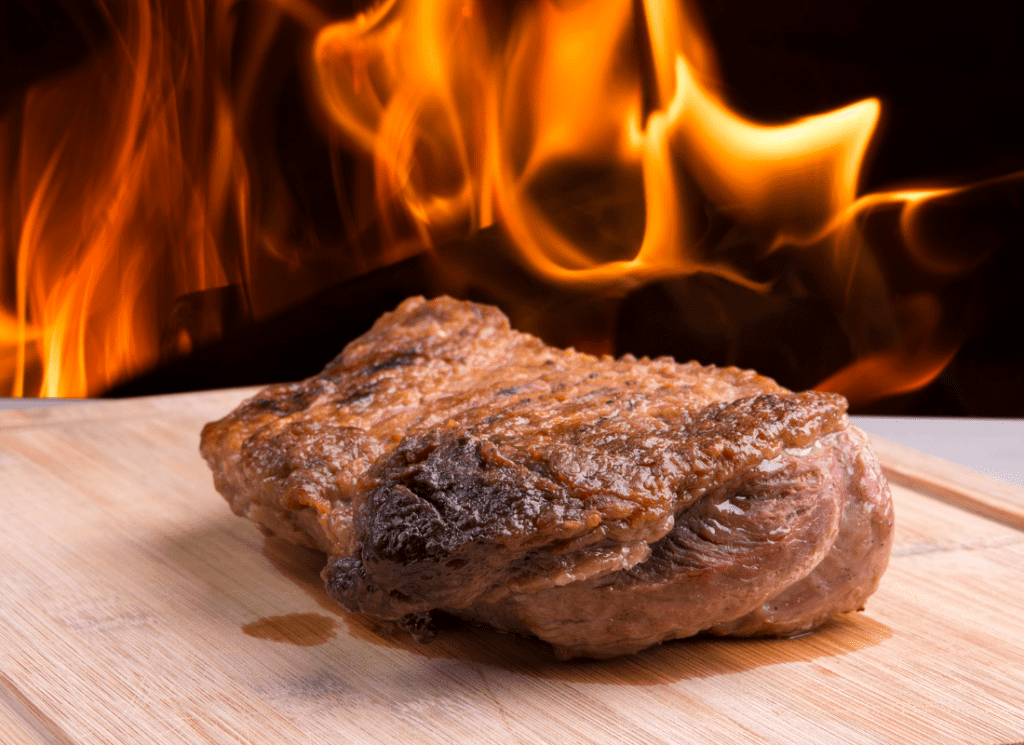
The first step is easy to forget but crucial. Failure to pat the meat dry inhibits the Maillard reaction needed to create a crust. Seasoning the meat adds flavor and induces the crust. Lastly, using extremely high heat creates the crust.
The three methods we would suggest for the high temperature sear are:
- Pan searing, preferably using cast iron
- Grilling, preferably over oak for a traditional Santa Maria tri-tip finish (further discussed below)
- Using a searing torch
You’ll want to sear for 1 to 2 minutes per side. The less time taken to reach your desired crust, the better. If pan searing, we prefer ghee (clarified butter) or a high smoke point oil such as avocado oil, but regular butter will do. Limiting to the sear to 2 minutes per side should prevent the steak from overcooking.
It requires marginally more work, but searing the steak for 30 seconds to a minute per side, 2 (or more) times each can add more color and texture and further prevent overcooking.
In the searing stage we’re doing our best to preserve the perfectly even doneness of the sous vide meat, while adding color, texture and taste to further its appeal.
Carving
Carving a tri tip is trickier than standard cuts of beef because the grain changes direction. Its important to take a moment to study the the grain pattern to carve against it.
These labels are a bit dubious, but I would describe the grain pattern on a tri tip as starting from the outer corner (the ~90° angled corner – if the tri tip were an arm, this would be your elbow) and fanning out from there to the two points.
Cut against the grain to create a tender bite. Cutting with the grain will create extra chew. I prefer roughly a quarter inch thick slices on a tri tip steak. Further guidance on how to cut against the grain is as follows.
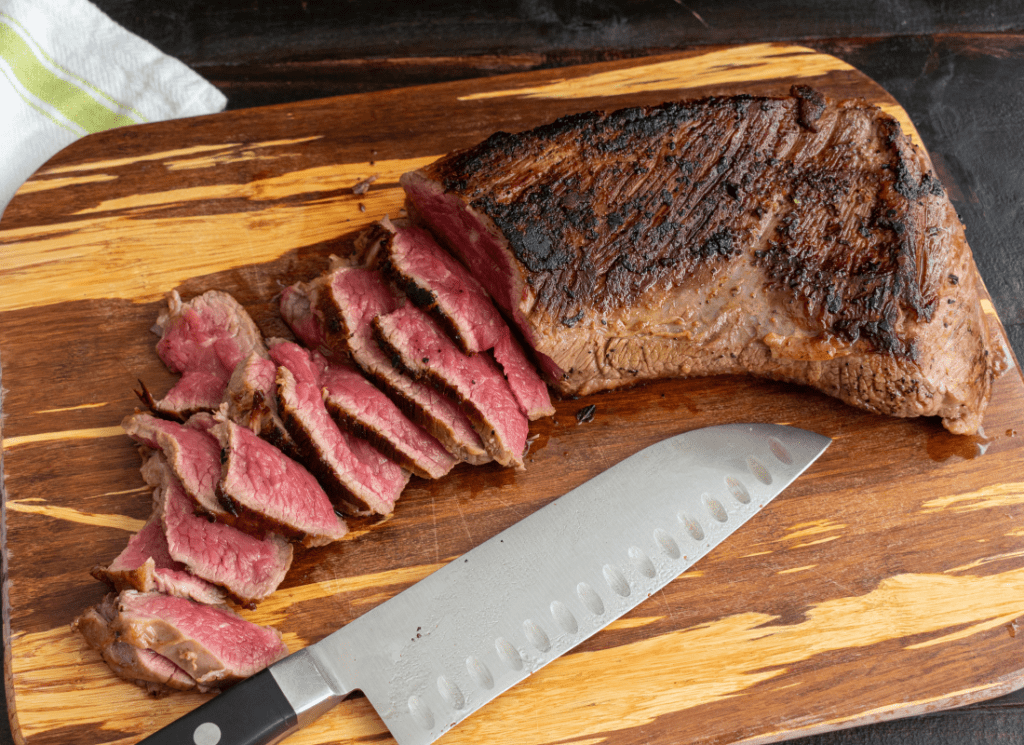
Start at the pointiest end (again, if the tri tip were an arm, this would be the hand side) and slice until you reach the inner corner (not the aforementioned elbow corner, but the one opposite where your bicep and forearm would meet).
Once you’ve reached the inner corner, rotate the tri tip ~45° as the grain changes direction here.
Carving in this manner should maximize the tenderness by minimizing the chew.
Where to Find Quality Tri Tip
Tri tip is a less common cut that can be found at your local butcher shop. You’re more likely to see it in grocery stores on the West Coast, where it is more common.
If you haven’t tried ordering online at Crowd Cow, I’d encourage you to do so. They have a large selection of high-quality meats and operate under the core tenents of taste, transparency and convenience. Use this limited time link for $10 off your first Crowd Cow order.
Crowd Cow connects you to 100+ small farms across 23 states. The selection ranges from competitively priced grocery store staples to restaurant quality craft and heritage meats.
Kitchen Equipment Needed
If you’re new to sous vide, we have a great post on sous vide starter kits to get you going equipment wise. Below we summarize the essentials.
Sous Vide Machine
This is the one piece of equipment that is critical to purchase to cook sous vide. It’s a portable machine that clamps onto a container to circulate, heat and regulate the water bath to the desired temperature.
Immersion circulators include the Anova Sous Vide Precision Cooker series and the Breville Joule Sous Vide Cooker. For a more complete comparison of sous vide cookers see our review of the 10 best sous vide machines.
Sous Vide Container
You don’t technically need a separate container and can use any metal pot at home, but I prefer a sous vide container. They’re lightweight, transparent and designed with sous vide cooking in mind.
We’ve reviewed the best sous vide containers to help you find one that best meets your needs.
Vacuum Sealer
If you’re serious about sous vide, a vacuum sealer deserves serious consideration. A vacuum sealer will eliminate the vast majority of bag issues that can cause your sous vide cook to go wayward.
Bonus, it will benefit you well beyond sous vide and likely pay for itself in short order. Check out our research on the best sous vide vacuum sealers.
Cast Iron Skillet
Not really unconventional, but if a cast iron skillet isn’t a part of your kitchen arsenal, it should be for sous vide. The heat retention of cast iron will go a long way in pan searing, which is the most common and versatile form of searing sous vide cooked food.
Lodge makes a great and affordable cast iron skillet. I’d go with an oversized searing skillet to accommodate larger cuts of meat, but a standard size searing skillet will do just fine in most cases.
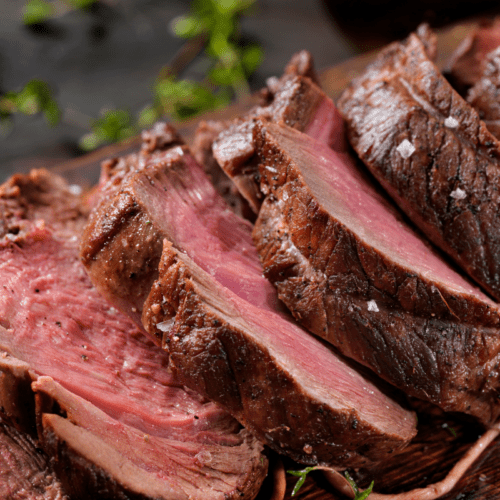
Sous Vide Tri-Tip Recipe
Equipment
- Sous Vide Cooker
- Sous Vide Container
- Vacuum Sealer optional
- Vacuum Seal Bags or Ziplock like bags
- Skillet or grill
Ingredients
- 2-3 lbs beef tri tip (~1kg)
- Salt and pepper to taste
- 2 sprigs fresh thyme
- 4 cloves garlic (minced)
- 4-5 tbsp butter
- 4 tbsp ghee (or butter) for a skillet finish or extra virgin olive oil for a grill finish
Instructions
- Set the sous vide machine to 54°C / 130°F to preheat the water.
- Season the tri tip generously with salt, pepper, garlic and thyme sprigs.
- Add 4 tbsp butter to the tri tip steak inside the bag and seal the sous vide bag.
- Put the bag in the sous vide container and let it cook for 4 hours.
- When the tri tip is ready, take it out of the vacuum sealed bag. Pat dry the tri tip.
- Put the pan on high heat and sear the tri tip on all sides with ghee, 1 to 2 minutes per side including edges (5-8 minutes total). Alternatively, for a more authentic Santa Maria style finish, sear the steak with olive oil over oak on a charcoal grill.
- When ready to eat, finish with salt, slice the tri tip steak against the grain and enjoy!
Beverage Pairing
Like most steak, we’d recommend red wine as a perfect beverage pairing for this meal. Note, the beef is lean enough to be paired with a heavier Pinot Noir, not just the traditional big reds like Sangiovese or Cabernets.
Additional Tri-Tip Information
Other Names for Tri-Tip
Tri-tip is more common on the west coast of the U.S. as it was popularized there (more on this below). In other parts of the country, the cut is also known as bottom sirloin butt or triangle roast. Santa Maria steak, Newport steak, and California cut can also be used to name the cut.
With so many ways to refer to the cut, you may need to refer your butcher to this page and say you’re looking for the top triangular shaped portion of the bottom sirloin pictured in top left-hand corner of the page (not the ball or the flap portion).
Tri-tip is also referred to as a poor man’s brisket, given the flavor profile is quite similar. Unlike a brisket, the tri-tip is relatively small at roughly 5 lbs. untrimmed, making it a much quicker cook than brisket.
Note, brisket comes from the front of the animal below the chuck whereas tri-tip is a steak from the rear.
Find our sous vide brisket recipe here!
Origin Story of Tri Tip
Up until the 1950s, tri-tip was generally ground up along with other cuts into hamburger meat. At the Santa Maria Market, butcher Bob Schutz is credited for originating the cut by preparing the steak rotisserie made, which was well received. He thought of the idea after having an excess of hamburger meat.
The cut soon became a favorite of ranchers in the area, who would prepare a regional marinade and cook the steak over coals of the native coast live oak wood, also known as red oak.
Tri Tip Sous Vide FAQs
Using an immersion circulator for four hours at 54°C / 130°F degrees temp is ideal, followed by a 5-8 minute sear.
YES. Sous vide is ideal to tenderize this mildly tough cut of meat. We’d prefer to finish the steaks over oak to add traditional flavor.
4 hours is ideal for traditional steak consistency, though 3 will suffice.
The longer time you sous vide, the more the meat will break down. We’re going for a traditional steak like consistency at 3-4 hours. Ten to twelve hours will get you to more of a tri tip roast consistency. Data says you can go as long as 24 hours before the meat starts to fall apart.
If you’re in the mood for an interesting short read, see The Colonel in the Kitchen: A Surprising History of Sous Vide.
Other Sous Vide Cooking Recipes
Check out other sous vide recipes to help make tasty food for family and friends:
- Sous Vide Ribeye Steak
- Sous Vide Roast Beef Recipe
- Sous Vide Flank Steak Recipe
- Steakhouse-Style Sous Vide London Broil Recipe
Only question for you before you get started. Do you know how to tell if steak is bad? We’re not into putting you in the hospital.


Sous vide cooking is great to make tri-tip tender and cooked perfectly. Thanks!